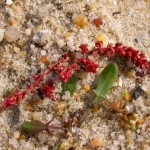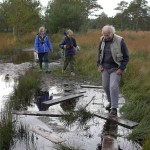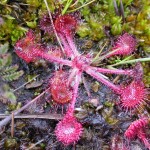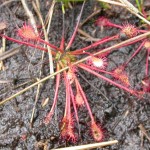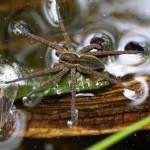Michael Keith-Lucas led a field trip on Sunday 30th September which visited 2 very different habitats. The morning walk was on the dry, sandy heathland around Frensham Pond, near Farnham, while the afternoon walk was on the wet bog at Thursley National Nature Reserve, a few miles to the east. Both sites are on the acid, infertile soils of the Lower Greensand. Some of the plants at Frensham are more typically found in coastal areas or in the Brecklands of East Anglia. Sand Sedge Carex arenaria has long rhizomes and these were sending up long lines of evenly-spaced plantlets. Small plants in the open area near the Visitor Centre included Common Stork’s-bill Erodium cicutarium, Sheep’s Sorrel Rumex acetosella, Mossy Stonecrop Crassula tillaea and Small Cudweed Filago minima. Bell Heather Erica cinerea, Ling Calluna vulgaris and Dwarf Gorse Ulex minor were all in flower. There were a number of the big and hairy caterpillars of the Fox Moth. Protected from trampling behind a fence was an area of lichen heath and a number of different species were identified – the delicate branched Cladonia portentosa, the more stumpy C. uncialis, the cups of C. chlorophaea and the browner C. rangiferina. Alder Buckthorn bushes were covered in black berries and there were some big colonies of wood ants.
The walk at Thursley started from the Moat car park, with White Water-lilies Nymphaea alba in the nearby pond. The dominant plants were sedges, rushes and mosses. There were 2 different kinds of carnivorous sundews – the Oblong-leaved variety Drosera intermedia on bare peat and the Round-leaved Sundew D. rotundifolia on moss, with the Marsh Clubmoss Lycopodiella inundata growing nearby. Raised water levels on the reserve meant that the track was flooded in several places, which forced some delicate balancing on submerged planks. Marsh St John’s-wort Hypericum elodes, Bog Asphodel Narthecium ossifragum, Bogbean Menyanthes trifoliata and a bladderwort were all growing near the path. A few late swallows and house martins were still to be seen. Towards the end of the walk, 2 raft spiders were spotted, lurking on the surface of the water next to the board walk.

